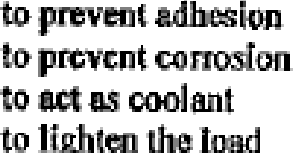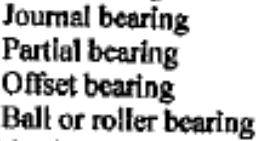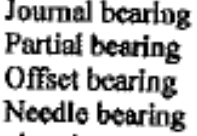Bearings
1/67
Earn XP
Description and Tags
Finals
Name | Mastery | Learn | Test | Matching | Spaced |
|---|
No study sessions yet.
68 Terms
bearings
a machine element which support another moving machine element (known as journal).
Bearings
It permits a relative motion between the contact surfaces of the members, while carrying the load.
lubricant
In order to reduce frictional resistance and wear and in some cases to carry away the heat generated, a layer of fluid (known as [ ] ) may be provided
lubricant
used to separate the journal and bearing is usually a mineral oil refined from petroleum, but vegetable oils, silicon oils, greases etc., may be used.
1. direction of load to be supported
a. radial bearings
b. Thrust bearings
2. nature of contact
a. Sliding contact bearings
b. Rolling contact bearings
Classifications of Bearings
Depending upon the
Depending upon the
radial bearing
the load acts perpendicular to the direction of motion of the moving element.
thrust bearings
the load acts along the axis of rotation.
sliding contact bearings
the sliding takes place along the surfaces of contact between the moving element and the fixed element.
are also known as plain bearings.
rolling contact bearings
steel balls or rollers, are interposed between the moving and fixed elements. The balls offer rolling friction at two points for each ball or roller.
full journal bearing
partial journal bearing.
fitted journal bearing
Types of Sliding Contact Bearings
slipper or guide bearings
The sliding contact bearings in which the sliding action is guided in a straight line and carrying radial loads
usually found in cross-head of steam engines.
journal or sleeve bearings
The sliding contact bearings in which the sliding action is along the circumference of a circle or an arc of a circle and carrying radial loads
full journal bearing
When the angle of contact of the bearing with the journal is 360°
full journal bearing
This type of bearing is commonly used in industrial machinery to accommodate bearing loads in any radial direction.
partial journal bearing
When the angle of contact of the bearing with the journal is 120°
partial journal bearing
This type of bearing has less friction than full journal bearing, but it can be used only where the load is always in one direction.
partial journal bearing
The most common application of the partial journal bearings is found in rail road car axles
clearance bearings
The full and partial journal bearings may be called as [ ] because the diameter of the journal is less than that of bearing.
fitted bearing
When a partial journal bearing has no clearance i.e. the diameters of the journal and bearing are equal,
Compressive strength
The maximum bearing pressure is considerably greater than the average pressure obtained by dividing the load to the projected area.
high compressive strength
Therefore the bearing material should have [ ] to withstand this maximum pressure so as to prevent extrusion or other permanent deformation of the bearing.
Fatigue strength
The bearing material should have sufficient [ ] so that it can withstand repeated loads without developing surface fatigue cracks. It is of major importance in aircraft and automotive engines.
Comformability
It is the ability of the bearing material to accommodate shaft deflections and bearing inaccuracies by plastic deformation (or creep) without excessive wear and heating.
Embeddability
. It is the ability of bearing material to accommodate (or embed) small
particles of dust, grit etc., without scoring the material of the journal.
Bondability
. Many high capacity bearings are made by bonding one or more thin layers of a
bearing material to a high strength steel shell. Thus, the strength of the bond i.e. [ ]
is an important consideration in selecting bearing material.
Corrosion resistance
. The bearing material should not corrode away
under the action of lubricating oil. This property is of particular
importance in internal combustion engines where the same oil is used
to lubricate the cylinder walls and bearings. In the cylinder, the
lubricating oil comes into contact with hot cylinder walls and may
oxidise and collect carbon deposits from the walls.
Thermal conductivity.
The bearing material should be of [ ] so as to permit the rapid removal of the heat generated by
friction.
Thermal expansion
. The bearing material should be of low coefficient of
[ ], so that when the bearing operates over a wide
range of temperature, there is no undue change in the clearance.
Lubricants
used in bearings to reduce friction between the rubbing surfaces and to carry away the heat generated by friction.
Lubricants
It also protects the bearing against corrosion.
liquid lubricants
used in bearings are mineral oils and synthetic oils.
mineral oils are most commonly used because of their cheapness and stability.
usually preferred where they may be retained.
semi-liquid lubricant
grease - higher viscosity than oils, employed where slow speed and heavy pressure exist and where oil drip from the bearing is undesirable
solid lubricants
useful in reducing friction where oil films cannot bemaintained because of pressures or temperatures.
softer than materials being lubricated.
graphite
is the most common of the solid
lubricants either alone or mixed with oil or grease.
14.3 ×10 6
Sommerfeld Number S
critical pressure or the minimum operating pressure
The pressure at which the oil film breaks down so that metal to metal contact begins, is known as
Sommerfeld number
is also a dimensionless parameter used extensively in the design of journal bearings.
Series No.
Numbering system “Y”
Number of 5 mms in the bearing bore
Numbering System: “XX” times how many?
1
1 reyn = (lb-sec)/in2
1
1 poise = (dyne-sec)/cm2
Petroff’s equation for frictional torque
In bearings

Condition of a hydrodynamic lubrication
In bearings

heat
generated in a bearing is due to the fluid friction and friction of the parts having relative motion.
thermal equilibrium
After the [ ] has been reached, heat will be dissipated at the outer surface of the bearing at the same rate at which it is generated in the oil film.
500
K1 of unhardened steel
700, 1500
K1 of hardened carbon steel
1000
K1 of alloy steel
2000
K1 of hardened alloy steel on grooved races
7000
K2 for hardened carbon steel
10000
K2 for hardened alloy steel
Hydrostatic bearing
is one which the lube oil is suppliec under pressure
Oil film pressure
In hydrodynamic bearings, [ ] is generated only by the roatation of the journal
Full bearing
bearing surface that completely surrounds the journal is called
full bearing
a type of bearing that totally encloses the shaft.
babbitt
a metal that assits lubrication or a lubricant itself
babbitt
a composition of antimony, lead, or tin alloy
low carbon steel
unsuitable as a bearing
offset bearing
also called eccentrically loaded bearing
0.0010
as a rule of thumb in journal bearing design, the clearance ratio should be:
kinematic viscosity
the absolute viscosity of the fluid divided by its density expressed in the same terms of units
graphite
the most known lubricants being utilized in watever category of load and speed are oil, air, grease and dry lubricants like.

to lighten the load

ZN/p


Ball or roller bearing


needle bearing

heavy load

Tapered roller bearing
